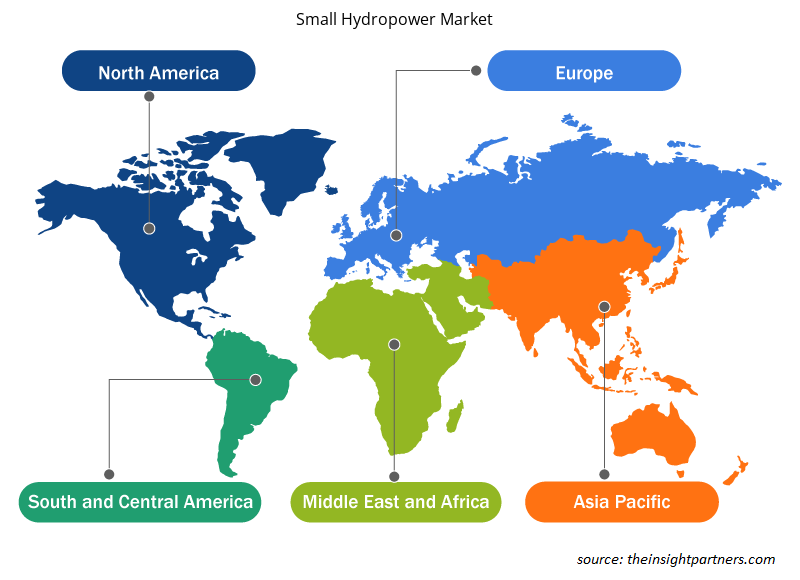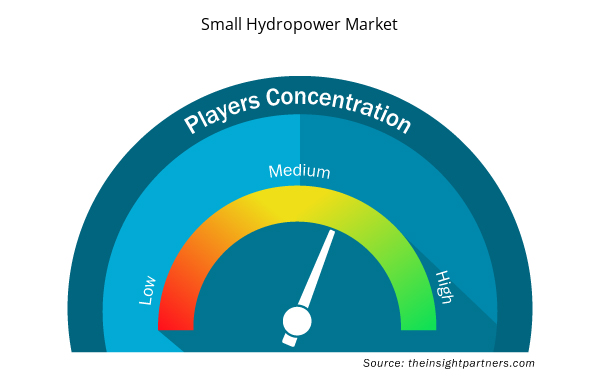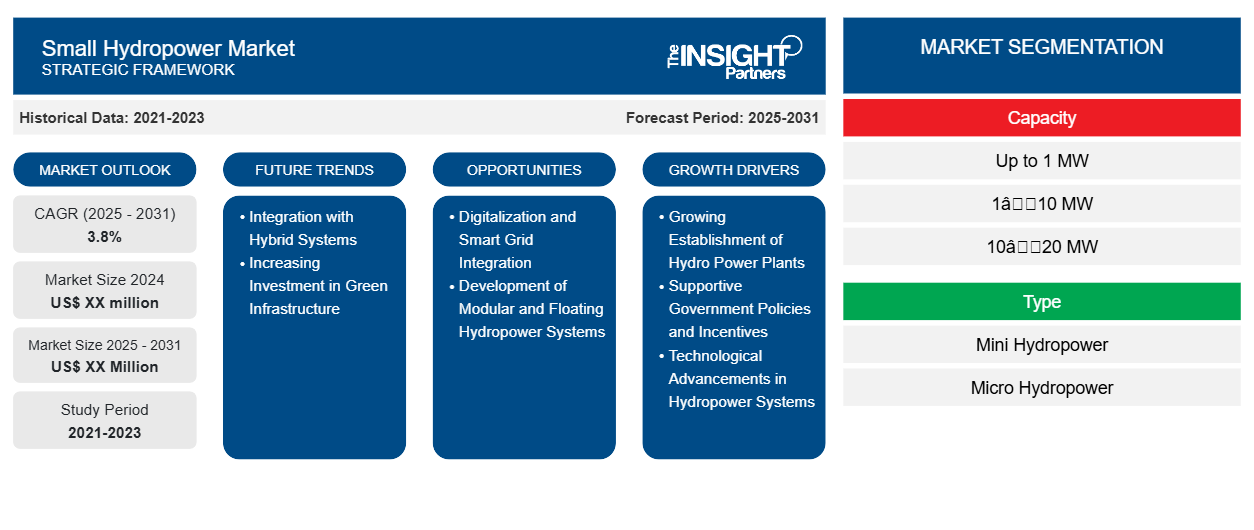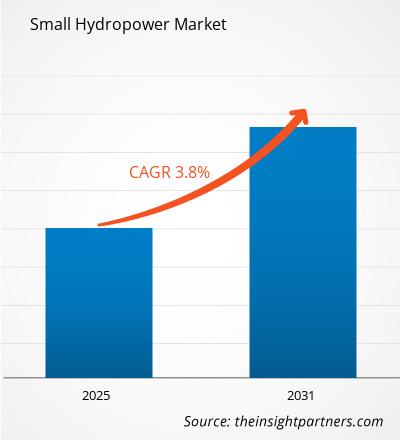Le marché de la petite hydroélectricité devrait enregistrer un TCAC de 3,8 % de 2024 à 2031, avec une taille de marché passant de XX millions USD en 2024 à XX millions USD d'ici 2031.
Le rapport est segmenté par capacité (jusqu'à 1 MW, 1-10 MW, 10-20 MW, 20-30 MW). Le rapport présente en outre une analyse basée sur le type (mini-centrale hydroélectrique, micro-centrale hydroélectrique). Le rapport présente en outre une analyse basée sur la configuration (au fil de l'eau, stockage d'eau). L'analyse globale est ensuite décomposée au niveau régional et par principaux pays. Le rapport offre la valeur en USD pour l'analyse et les segments ci-dessus.
Objectif du rapport
Le rapport Small Hydropower Market de The Insight Partners vise à décrire le paysage actuel et la croissance future, les principaux facteurs moteurs, les défis et les opportunités. Cela fournira des informations à diverses parties prenantes commerciales, telles que :
- Fournisseurs/fabricants de technologie : pour comprendre l’évolution de la dynamique du marché et connaître les opportunités de croissance potentielles, leur permettant de prendre des décisions stratégiques éclairées.
- Investisseurs : Effectuer une analyse complète des tendances concernant le taux de croissance du marché, les projections financières du marché et les opportunités qui existent tout au long de la chaîne de valeur.
- Organismes de réglementation : Réglementer les politiques et surveiller les activités du marché dans le but de minimiser les abus, de préserver la confiance des investisseurs et de maintenir l’intégrité et la stabilité du marché.
Segmentation du marché de la petite hydroélectricité
Capacité
- Jusqu'à 1 MW
- 1 à 10 MW
- 10-20 MW
- 20-30 MW
Taper
- Mini-centrale hydroélectrique
- Microcentrales hydroélectriques
Configuration
- Au fil de l'eau
- Stockage de l'eau
Géographie
- Amérique du Nord
- Europe
- Asie-Pacifique
- Amérique du Sud et Amérique centrale
- Moyen-Orient et Afrique
Personnalisez ce rapport en fonction de vos besoins
Vous bénéficierez d'une personnalisation gratuite de n'importe quel rapport, y compris de certaines parties de ce rapport, d'une analyse au niveau des pays, d'un pack de données Excel, ainsi que d'offres et de remises exceptionnelles pour les start-ups et les universités.
- Obtenez les principales tendances clés du marché de ce rapport.Cet échantillon GRATUIT comprendra une analyse de données, allant des tendances du marché aux estimations et prévisions.
Facteurs de croissance du marché de la petite hydroélectricité
- Implantation croissante de centrales hydroélectriques : La croissance mondiale de la demande énergétique, alimentée par la croissance démographique et l'industrialisation, nécessite l'expansion de la production énergétique qui, à son tour, devrait stimuler la croissance du marché de la production hydroélectrique. L'hydroélectricité peut fournir une part importante de l'électricité nécessaire pour répondre à cette demande, contribuant ainsi à un approvisionnement énergétique fiable. En outre, la sécurité énergétique est un facteur fondamental de l'expansion mondiale de l'hydroélectricité. Les pays recherchent des sources d'énergie diverses et fiables pour réduire leur dépendance aux combustibles fossiles, garantissant ainsi un approvisionnement énergétique stable pour la croissance économique et la sécurité nationale. Une telle augmentation de l'implantation de centrales hydroélectriques devrait stimuler le marché de la petite hydroélectricité dans les années à venir.
- Politiques et incitations gouvernementales favorables : Partout dans le monde, les politiques et incitations favorables des gouvernements encouragent davantage de personnes à se tourner vers les sources d’énergie renouvelables telles que la petite hydroélectricité. En fait, cela va de l’octroi de subventions et de réductions d’impôts à des subventions directes, y compris des prêts à faible taux d’intérêt. Divers tarifs de rachat garantis (FIT) et accords d’achat d’électricité sont proposés par les gouvernements respectifs dans plusieurs cas, de sorte que l’électricité produite par ces petites centrales hydroélectriques soit garantie à son prix de vente sur les réseaux respectifs pendant de longues périodes. Les politiques et incitations favorables favorisent la croissance du marché de la petite hydroélectricité.
- Progrès technologiques dans les systèmes hydroélectriques : Les progrès dans la technologie hydroélectrique, en particulier dans la conception et l’efficacité des turbines, rendent les systèmes hydroélectriques de petite taille attrayants et rentables. Les technologies des turbines à basse chute, des systèmes de micro-hydroélectricité et des conceptions hydroélectriques modulaires contribuent au développement de centrales hydroélectriques plus efficaces et plus flexibles. De tels systèmes peuvent être facilement installés dans les rivières, les ruisseaux et les canaux avec une perturbation minimale de l’écosystème local, ce qui rend la petite hydroélectricité de plus en plus viable dans les régions où l’hydroélectricité traditionnelle à grande échelle ne peut pas être déployée. En outre, de nouvelles améliorations dans l’innovation technologique en matière de stockage d’énergie et d’intégration au réseau intelligent renforcent le rôle de la petite hydroélectricité dans les systèmes énergétiques locaux.
Tendances futures du marché de la petite hydroélectricité
- Intégration aux systèmes hybrides : la petite hydroélectricité peut être intégrée dans des systèmes énergétiques hybrides qui combinent diverses sources d’énergie renouvelables comme le solaire, l’éolien et la biomasse, ainsi que des solutions de stockage d’énergie. Les systèmes hybrides permettent une alimentation électrique plus fiable et plus constante en raison de l’effet de compensation de l’intermittence de l’énergie solaire et éolienne par rapport à la capacité de production continue de la petite hydroélectricité. Cette intégration est prometteuse et pourrait rendre les petites centrales hydroélectriques plus efficaces et plus fiables, et devenir ainsi un bon candidat pour les applications connectées et hors connexion.
- Augmenter les investissements dans les infrastructures vertes : Avec l’essor mondial du développement d’infrastructures durables, les investissements dans les technologies vertes, notamment la petite hydroélectricité, deviennent de plus en plus populaires. Les gouvernements et les investisseurs privés se rendent compte de l’importance de la transition vers des systèmes énergétiques durables et respectueux de l’environnement et considèrent donc progressivement la petite hydroélectricité comme une source d’énergie viable et à faible impact. Cette tendance représente donc une opportunité importante pour le marché, car les projets de petite hydroélectricité soutiennent l’objectif plus large d’une économie à faible émission de carbone et contribuent également à stimuler la création d’emplois et le développement économique local.
Opportunités de marché pour la petite hydroélectricité
- Numérisation et intégration des réseaux intelligents : la croissance future du marché de la petite hydroélectricité dépendra essentiellement de l’intégration des technologies de réseaux intelligents et de la numérisation. Les réseaux intelligents permettent une gestion plus efficace de la production, du stockage et de la distribution d’électricité de manière plus efficace et plus flexible. La surveillance à distance et l’analyse des données peuvent optimiser les performances des opérateurs, réduire les coûts de maintenance et les rendre plus fiables. Cette tendance vers une automatisation et un contrôle accrus orientera le développement futur des petits systèmes hydroélectriques vers l’efficacité, la fiabilité et la flexibilité.
- Développement de systèmes hydroélectriques modulaires et flottants : Une autre tendance intéressante est celle du développement de petits systèmes hydroélectriques modulaires et flottants. Les systèmes hydroélectriques flottants sont construits pour fonctionner sur des lacs, des réservoirs et des canaux comme des solutions uniques là où l'installation d'installations terrestres traditionnelles devient impossible. Les systèmes peuvent être rapidement agrandis ou réduits ; par conséquent, ils peuvent répondre à divers degrés de besoins énergétiques faibles, mais souvent nécessaires. Les conceptions modulaires permettent également un déploiement peu coûteux et plus rapide, ce qui en fait un excellent choix pour les zones reculées et les petites communautés.
Aperçu régional du marché de la petite hydroélectricité
Les tendances et facteurs régionaux influençant le marché de la petite hydroélectricité tout au long de la période de prévision ont été expliqués en détail par les analystes d'Insight Partners. Cette section traite également des segments et de la géographie du marché de la petite hydroélectricité en Amérique du Nord, en Europe, en Asie-Pacifique, au Moyen-Orient et en Afrique, ainsi qu'en Amérique du Sud et en Amérique centrale.

- Obtenez les données régionales spécifiques au marché de la petite hydroélectricité
Portée du rapport sur le marché de la petite hydroélectricité
| Attribut de rapport | Détails |
|---|---|
| Taille du marché en 2024 | XX millions de dollars américains |
| Taille du marché d'ici 2031 | XX millions de dollars américains |
| Taux de croissance annuel composé mondial (2025-2031) | 3,8% |
| Données historiques | 2021-2023 |
| Période de prévision | 2025-2031 |
| Segments couverts | Par capacité
|
| Régions et pays couverts | Amérique du Nord
|
| Leaders du marché et profils d'entreprises clés |
|
Densité des acteurs du marché de la petite hydroélectricité : comprendre son impact sur la dynamique des entreprises
Le marché de la petite hydroélectricité connaît une croissance rapide, tirée par la demande croissante des utilisateurs finaux en raison de facteurs tels que l'évolution des préférences des consommateurs, les avancées technologiques et une plus grande sensibilisation aux avantages du produit. À mesure que la demande augmente, les entreprises élargissent leurs offres, innovent pour répondre aux besoins des consommateurs et capitalisent sur les tendances émergentes, ce qui alimente davantage la croissance du marché.
La densité des acteurs du marché fait référence à la répartition des entreprises ou des sociétés opérant sur un marché ou un secteur particulier. Elle indique le nombre de concurrents (acteurs du marché) présents sur un marché donné par rapport à sa taille ou à sa valeur marchande totale.
Les principales entreprises opérant sur le marché de la petite hydroélectricité sont :
- ANDRITZ AG
- B fouress (P) Ltd
- Compagnie Générale d'Électricité
- Gilbert Gilkes et Gordon Ltd
- Énergie Greenbug Inc.
Avis de non-responsabilité : les sociétés répertoriées ci-dessus ne sont pas classées dans un ordre particulier.

- Obtenez un aperçu des principaux acteurs du marché de la petite hydroélectricité
Principaux arguments de vente
- Couverture complète : Le rapport couvre de manière exhaustive l’analyse des produits, des services, des types et des utilisateurs finaux du marché de la petite hydroélectricité, offrant un paysage holistique.
- Analyse d’experts : Le rapport est compilé sur la base d’une compréhension approfondie des experts et analystes du secteur.
- Informations à jour : Le rapport garantit la pertinence commerciale en raison de sa couverture des informations récentes et des tendances des données.
- Options de personnalisation : ce rapport peut être personnalisé pour répondre aux exigences spécifiques du client et s'adapter parfaitement aux stratégies commerciales.
Le rapport de recherche sur le marché de la petite hydroélectricité peut donc aider à ouvrir la voie au décodage et à la compréhension du scénario de l’industrie et des perspectives de croissance. Bien qu’il puisse y avoir quelques préoccupations valables, les avantages globaux de ce rapport ont tendance à l’emporter sur les inconvénients.
- Analyse historique (2 ans), année de base, prévision (7 ans) avec TCAC
- Analyse PEST et SWO
- Taille du marché Valeur / Volume - Mondial, Régional, Pays
- Industrie et paysage concurrentiel
- Ensemble de données Excel



Report Coverage
Revenue forecast, Company Analysis, Industry landscape, Growth factors, and Trends

Segment Covered
This text is related
to segments covered.

Regional Scope
North America, Europe, Asia Pacific, Middle East & Africa, South & Central America

Country Scope
This text is related
to country scope.
Questions fréquemment posées
Some of the customization options available based on the request are an additional 3-5 company profiles and country-specific analysis of 3-5 countries of your choice. Customizations are to be requested/discussed before making final order confirmation, as our team would review the same and check the feasibility.
The report can be delivered in PDF/PPT format; we can also share excel dataset based on the request.
The leading players operating in the Small Hydropower Market include ANDRITZ AG, Hitachi Mitsubishi Hydro Corporation, GENERAL ELECTRIC, Natel Energy, Siemens Energy, Voith GmbH and Co. KGaA, Toshiba Energy Systems and Solutions Corporation, Canadian Hydro Components Ltd., Bharat Heavy Electricals Limited, and Canyon Hydro
Integration with Hybrid Systems is the key future trend of the Small Hydropower Market
The Small Hydropower Market is estimated to witness a CAGR of 3.8% from 2023 to 2031
The major factors driving the Small Hydropower Market are: Growing Establishment of Hydro Power Plants and Supportive Government Policies and Incentives
Trends and growth analysis reports related to Energy and Power : READ MORE..
1. ANDRITZ AG
2. B fouress(P) Ltd
3. General Electric Company
4. Gilbert Gilkes and Gordon Ltd
5. Greenbug Energy Inc.
6. Kolektor Turboinštitut d.o.o.
7. Siemens AG
8. SNC-Lavalin Group
9. Toshiba Energy Systems and Solutions Corporation
10. Voith GmbH and Co. KGaA
The Insight Partners performs research in 4 major stages: Data Collection & Secondary Research, Primary Research, Data Analysis and Data Triangulation & Final Review.
- Data Collection and Secondary Research:
As a market research and consulting firm operating from a decade, we have published and advised several client across the globe. First step for any study will start with an assessment of currently available data and insights from existing reports. Further, historical and current market information is collected from Investor Presentations, Annual Reports, SEC Filings, etc., and other information related to company’s performance and market positioning are gathered from Paid Databases (Factiva, Hoovers, and Reuters) and various other publications available in public domain.
Several associations trade associates, technical forums, institutes, societies and organization are accessed to gain technical as well as market related insights through their publications such as research papers, blogs and press releases related to the studies are referred to get cues about the market. Further, white papers, journals, magazines, and other news articles published in last 3 years are scrutinized and analyzed to understand the current market trends.
- Primary Research:
The primarily interview analysis comprise of data obtained from industry participants interview and answers to survey questions gathered by in-house primary team.
For primary research, interviews are conducted with industry experts/CEOs/Marketing Managers/VPs/Subject Matter Experts from both demand and supply side to get a 360-degree view of the market. The primary team conducts several interviews based on the complexity of the markets to understand the various market trends and dynamics which makes research more credible and precise.
A typical research interview fulfils the following functions:
- Provides first-hand information on the market size, market trends, growth trends, competitive landscape, and outlook
- Validates and strengthens in-house secondary research findings
- Develops the analysis team’s expertise and market understanding
Primary research involves email interactions and telephone interviews for each market, category, segment, and sub-segment across geographies. The participants who typically take part in such a process include, but are not limited to:
- Industry participants: VPs, business development managers, market intelligence managers and national sales managers
- Outside experts: Valuation experts, research analysts and key opinion leaders specializing in the electronics and semiconductor industry.
Below is the breakup of our primary respondents by company, designation, and region:

Once we receive the confirmation from primary research sources or primary respondents, we finalize the base year market estimation and forecast the data as per the macroeconomic and microeconomic factors assessed during data collection.
- Data Analysis:
Once data is validated through both secondary as well as primary respondents, we finalize the market estimations by hypothesis formulation and factor analysis at regional and country level.
- Macro-Economic Factor Analysis:
We analyse macroeconomic indicators such the gross domestic product (GDP), increase in the demand for goods and services across industries, technological advancement, regional economic growth, governmental policies, the influence of COVID-19, PEST analysis, and other aspects. This analysis aids in setting benchmarks for various nations/regions and approximating market splits. Additionally, the general trend of the aforementioned components aid in determining the market's development possibilities.
- Country Level Data:
Various factors that are especially aligned to the country are taken into account to determine the market size for a certain area and country, including the presence of vendors, such as headquarters and offices, the country's GDP, demand patterns, and industry growth. To comprehend the market dynamics for the nation, a number of growth variables, inhibitors, application areas, and current market trends are researched. The aforementioned elements aid in determining the country's overall market's growth potential.
- Company Profile:
The “Table of Contents” is formulated by listing and analyzing more than 25 - 30 companies operating in the market ecosystem across geographies. However, we profile only 10 companies as a standard practice in our syndicate reports. These 10 companies comprise leading, emerging, and regional players. Nonetheless, our analysis is not restricted to the 10 listed companies, we also analyze other companies present in the market to develop a holistic view and understand the prevailing trends. The “Company Profiles” section in the report covers key facts, business description, products & services, financial information, SWOT analysis, and key developments. The financial information presented is extracted from the annual reports and official documents of the publicly listed companies. Upon collecting the information for the sections of respective companies, we verify them via various primary sources and then compile the data in respective company profiles. The company level information helps us in deriving the base number as well as in forecasting the market size.
- Developing Base Number:
Aggregation of sales statistics (2020-2022) and macro-economic factor, and other secondary and primary research insights are utilized to arrive at base number and related market shares for 2022. The data gaps are identified in this step and relevant market data is analyzed, collected from paid primary interviews or databases. On finalizing the base year market size, forecasts are developed on the basis of macro-economic, industry and market growth factors and company level analysis.
- Data Triangulation and Final Review:
The market findings and base year market size calculations are validated from supply as well as demand side. Demand side validations are based on macro-economic factor analysis and benchmarks for respective regions and countries. In case of supply side validations, revenues of major companies are estimated (in case not available) based on industry benchmark, approximate number of employees, product portfolio, and primary interviews revenues are gathered. Further revenue from target product/service segment is assessed to avoid overshooting of market statistics. In case of heavy deviations between supply and demand side values, all thes steps are repeated to achieve synchronization.
We follow an iterative model, wherein we share our research findings with Subject Matter Experts (SME’s) and Key Opinion Leaders (KOLs) until consensus view of the market is not formulated – this model negates any drastic deviation in the opinions of experts. Only validated and universally acceptable research findings are quoted in our reports.
We have important check points that we use to validate our research findings – which we call – data triangulation, where we validate the information, we generate from secondary sources with primary interviews and then we re-validate with our internal data bases and Subject matter experts. This comprehensive model enables us to deliver high quality, reliable data in shortest possible time.


 Obtenez un échantillon gratuit pour ce rapport
Obtenez un échantillon gratuit pour ce rapport